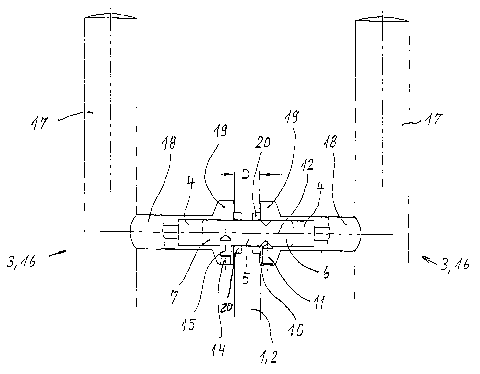Some of the information on this Web page has been provided by external sources. The Government of Canada is not responsible for the accuracy, reliability or currency of the information supplied by external sources. Users wishing to rely upon this information should consult directly with the source of the information. Content provided by external sources is not subject to official languages, privacy and accessibility requirements.
Any discrepancies in the text and image of the Claims and Abstract are due to differing posting times. Text of the Claims and Abstract are posted:
| (12) Patent Application: | (11) CA 2512888 |
|---|---|
| (54) English Title: | DEVICE FOR FASTENING DOOR HANDLES |
| (54) French Title: | DISPOSITIF POUR LA FIXATION DE POIGNEES DE PORTE |
| Status: | Deemed Abandoned and Beyond the Period of Reinstatement - Pending Response to Notice of Disregarded Communication |
| (51) International Patent Classification (IPC): |
|
|---|---|
| (72) Inventors : |
|
| (73) Owners : |
|
| (71) Applicants : |
|
| (74) Agent: | NORTON ROSE FULBRIGHT CANADA LLP/S.E.N.C.R.L., S.R.L. |
| (74) Associate agent: | |
| (45) Issued: | |
| (86) PCT Filing Date: | 2004-08-17 |
| (87) Open to Public Inspection: | 2005-03-31 |
| Availability of licence: | N/A |
| Dedicated to the Public: | N/A |
| (25) Language of filing: | English |
| Patent Cooperation Treaty (PCT): | Yes |
|---|---|
| (86) PCT Filing Number: | PCT/EP2004/009187 |
| (87) International Publication Number: | WO 2005028786 |
| (85) National Entry: | 2005-07-07 |
| (30) Application Priority Data: | ||||||
|---|---|---|---|---|---|---|
|
The invention relates to a device for fastening door handles (3). A pocket
bore (4) is provided on each door handle (3) for accommodating a pin (8) that
can be locked by means of each door handle (3). The invention is characterized
in that the opposite door handles (3) of an armature are embodied in an
identical manner while several centering bores (13) into which a threaded
screw (15) is to engage are disposed on one of the two final sections (7) of
the pin (8), said centering bores (13) being offset both in the
circumferential direction and relative to the longitudinal axis (12) of the
pin (8).
L'invention concerne un dispositif de fixation de poignées de porte (3), procédé selon lequel un trou borgne (4) est ménagé sur chaque poignée de porte (3) pour recevoir un goujon (8) pouvant être bloqué avec chaque poignée de porte. L'invention est fondée sur le fait que les poignées de porte (3) opposées d'une ferrure sont identiques et que sur une des deux parties d'extrémité (7) du goujon (8) sont formés, pour l'insertion d'une vis (15), plusieurs alésages (13) qui sont décalés tant dans le sens circonférentiel que par rapport à l'axe longitudinal (12) du goujon (8).
Note: Claims are shown in the official language in which they were submitted.
Note: Descriptions are shown in the official language in which they were submitted.

2024-08-01:As part of the Next Generation Patents (NGP) transition, the Canadian Patents Database (CPD) now contains a more detailed Event History, which replicates the Event Log of our new back-office solution.
Please note that "Inactive:" events refers to events no longer in use in our new back-office solution.
For a clearer understanding of the status of the application/patent presented on this page, the site Disclaimer , as well as the definitions for Patent , Event History , Maintenance Fee and Payment History should be consulted.
| Description | Date |
|---|---|
| Application Not Reinstated by Deadline | 2007-08-17 |
| Time Limit for Reversal Expired | 2007-08-17 |
| Deemed Abandoned - Failure to Respond to Maintenance Fee Notice | 2006-08-17 |
| Inactive: IPC from MCD | 2006-03-12 |
| Inactive: Cover page published | 2005-09-27 |
| Letter Sent | 2005-09-23 |
| Correct Applicant Requirements Determined Compliant | 2005-09-23 |
| Inactive: Notice - National entry - No RFE | 2005-09-23 |
| Application Received - PCT | 2005-09-01 |
| National Entry Requirements Determined Compliant | 2005-07-07 |
| Application Published (Open to Public Inspection) | 2005-03-31 |
| Abandonment Date | Reason | Reinstatement Date |
|---|---|---|
| 2006-08-17 |
| Fee Type | Anniversary Year | Due Date | Paid Date |
|---|---|---|---|
| Basic national fee - standard | 2005-07-07 | ||
| Registration of a document | 2005-07-07 |
Note: Records showing the ownership history in alphabetical order.
| Current Owners on Record |
|---|
| DORMA GMBH + CO. KG |
| Past Owners on Record |
|---|
| RALF KREYENBORG |